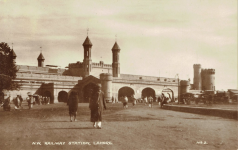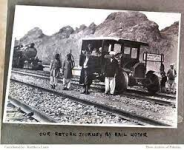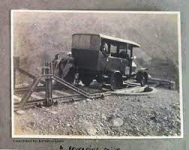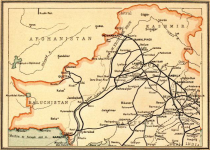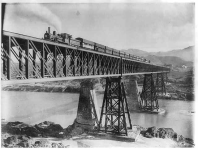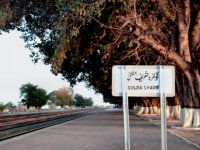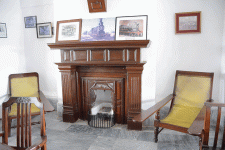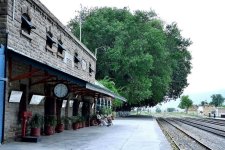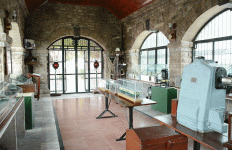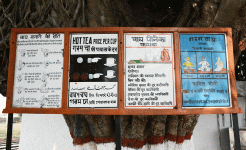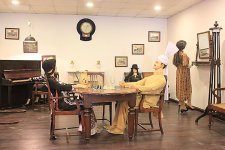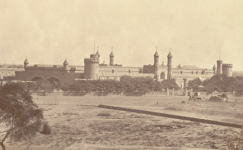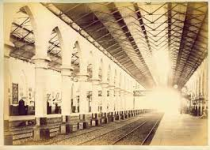ghazi52
THINK TANK: CONSULTANT
- Mar 21, 2007
- 117,059
- 167,230
- Country of Origin

- Country of Residence

History of “Pakistan Railways"
The idea of a rail network was first thought of in 1847, with the possibility of Karachi becoming a major seaport. Sir Henry Edward Frere, who was appointed as the Commissioner of Sindh, sought permission from Lord Dalhousie to begin a survey for a Karachi Seaport and a survey for a railway line in 1858. The proposed railway line would be laid from Karachi (city) to Kotri. A steamboat service on the Indus and Chenab rivers would connect Kotri to Multan and from there another railway line would be laid to Lahore and beyond.
On 13 May 1861, the first railway line was opened to the public, between Karachi and Kotri, with a total length of 169 kilometres (105 mi). A Lahore-Multan 336 kilometres (209 mi) railway line was opened for traffic on 24 April 1865. On 6 October 1876 three bridges on the Ravi, Chenab and Jhelum rivers were completed and a Lahore-Jhelum railway line opened. On 1 July 1878 a Lodhran-Pano Akil 334 kilometres (208 mi) section was inaugurated.
By 1885, there were four railway companies operating in what would become Pakistan: Scinde (Sindh) Railways, Indian Flotilla Company, Punjab Railway and Delhi Railways. These were amalgamated into the Scinde, Punjab & Delhi Railways Company and purchased by the Secretary of State for India in 1885, and in January 1886 formed the North Western State Railway, which was later on renamed North Western Railway (NWR). It was renamed Pakistan Western Railway in February 1961 and Pakistan Railways in May 1974.
It was the year 1857 when the idea was suggested by William Andrew (Chairman of Scinde, Punjab and Delhi Railway) that the railways to the Bolan Pass would have a strategic role in responding to any threat by Russia. During the second Afghan War (1878–80) between Britain and Afghanistan, there was a new need to construct a railway line up to Quetta in order to get easier access to the frontier.
On 18 September 1879, under the orders of the Viceroyal council, work began on laying the railway tracks, and after four months the first 215 km of the line from Ruk to Sibi was completed; it became operational in January 1880. Beyond Sibi the terrain was very difficult. After immense difficulties and harsh weather conditions, it was March 1887 when the railway line, over 320 km long, finally reached Quetta.
On 27 October 1878 a Kotri-Sukkur railway line on west bank of Indus river was opened for traffic. The Lansdowne Bridge over the Indus connecting Rohri and Sukkur was inaugurated on 25 March 1889. The completion of this bridge connected Karachi with Peshawar by rail.
By 1898, as the network began to grow, another proposed railway line from Peshawar to Karachi was in the works. It closely followed the route taken by Alexander the Great and his army while marching through the Hindu Kush to the Arabian Sea. During the early 20th century, railway lines were also laid down between Peshawar and Rawalpindi and Rawalpindi to Lahore.
Different sections on the existing mainline from Peshawar and branch lines were constructed in the last quarter of the 19th century and the early 20th century. months the first 215 km of the line from Ruk to Sibi was completed; it became operational in January 1880. Beyond Sibi, the terrain was very difficult.
After immense difficulties and harsh weather conditions, it was March 1887 when the railway line, over 320 km long, finally reached Quetta.tta.
In 1947, at the time of independence, 3,133 route kilometres (1,947 mi) of the North Western Railway were transferred to India, leaving 8,122 route kilometres (5,048 mi) to Pakistan. Of this 6,880 route kilometres (4,280 mi) were 1,676 mm (5 ft 6 in), 506 kilometres (314 mi) were 1,000 mm (3 ft 3 3⁄8 in), and 736 kilometres (457 mi) were 2 ft 6 in (762 mm) narrow gauge.
It was the year 1857 when the idea was suggested by William Andrew (Chairman of Scinde, Punjab and Delhi Railway) that the railways to the Bolan Pass would have a strategic role in responding to any threat by Russia. During the second Afghan War (1878–80) between Britain and Afghanistan, there was a new need to construct a railway line up to Quetta in order to get easier access to the frontier.
On 18 September 1879, under the orders of the Viceroyal council, work began on laying the railway tracks, and after four months the first 215 km of the line from Ruk to Sibi was completed; it became operational in January 1880. Beyond Sibi, the terrain was very difficult. After immense difficulties and harsh weather conditions, it was March 1887 when the railway line, over 320 km long, finally reached Quetta.tta.nally reached Quetta.
The idea of a rail network was first thought of in 1847, with the possibility of Karachi becoming a major seaport. Sir Henry Edward Frere, who was appointed as the Commissioner of Sindh, sought permission from Lord Dalhousie to begin a survey for a Karachi Seaport and a survey for a railway line in 1858. The proposed railway line would be laid from Karachi (city) to Kotri. A steamboat service on the Indus and Chenab rivers would connect Kotri to Multan and from there another railway line would be laid to Lahore and beyond.
On 13 May 1861, the first railway line was opened to the public, between Karachi and Kotri, with a total length of 169 kilometres (105 mi). A Lahore-Multan 336 kilometres (209 mi) railway line was opened for traffic on 24 April 1865. On 6 October 1876 three bridges on the Ravi, Chenab and Jhelum rivers were completed and a Lahore-Jhelum railway line opened. On 1 July 1878 a Lodhran-Pano Akil 334 kilometres (208 mi) section was inaugurated.
By 1885, there were four railway companies operating in what would become Pakistan: Scinde (Sindh) Railways, Indian Flotilla Company, Punjab Railway and Delhi Railways. These were amalgamated into the Scinde, Punjab & Delhi Railways Company and purchased by the Secretary of State for India in 1885, and in January 1886 formed the North Western State Railway, which was later on renamed North Western Railway (NWR). It was renamed Pakistan Western Railway in February 1961 and Pakistan Railways in May 1974.
It was the year 1857 when the idea was suggested by William Andrew (Chairman of Scinde, Punjab and Delhi Railway) that the railways to the Bolan Pass would have a strategic role in responding to any threat by Russia. During the second Afghan War (1878–80) between Britain and Afghanistan, there was a new need to construct a railway line up to Quetta in order to get easier access to the frontier.
On 18 September 1879, under the orders of the Viceroyal council, work began on laying the railway tracks, and after four months the first 215 km of the line from Ruk to Sibi was completed; it became operational in January 1880. Beyond Sibi the terrain was very difficult. After immense difficulties and harsh weather conditions, it was March 1887 when the railway line, over 320 km long, finally reached Quetta.
On 27 October 1878 a Kotri-Sukkur railway line on west bank of Indus river was opened for traffic. The Lansdowne Bridge over the Indus connecting Rohri and Sukkur was inaugurated on 25 March 1889. The completion of this bridge connected Karachi with Peshawar by rail.
By 1898, as the network began to grow, another proposed railway line from Peshawar to Karachi was in the works. It closely followed the route taken by Alexander the Great and his army while marching through the Hindu Kush to the Arabian Sea. During the early 20th century, railway lines were also laid down between Peshawar and Rawalpindi and Rawalpindi to Lahore.
Different sections on the existing mainline from Peshawar and branch lines were constructed in the last quarter of the 19th century and the early 20th century. months the first 215 km of the line from Ruk to Sibi was completed; it became operational in January 1880. Beyond Sibi, the terrain was very difficult.
After immense difficulties and harsh weather conditions, it was March 1887 when the railway line, over 320 km long, finally reached Quetta.tta.
In 1947, at the time of independence, 3,133 route kilometres (1,947 mi) of the North Western Railway were transferred to India, leaving 8,122 route kilometres (5,048 mi) to Pakistan. Of this 6,880 route kilometres (4,280 mi) were 1,676 mm (5 ft 6 in), 506 kilometres (314 mi) were 1,000 mm (3 ft 3 3⁄8 in), and 736 kilometres (457 mi) were 2 ft 6 in (762 mm) narrow gauge.
It was the year 1857 when the idea was suggested by William Andrew (Chairman of Scinde, Punjab and Delhi Railway) that the railways to the Bolan Pass would have a strategic role in responding to any threat by Russia. During the second Afghan War (1878–80) between Britain and Afghanistan, there was a new need to construct a railway line up to Quetta in order to get easier access to the frontier.
On 18 September 1879, under the orders of the Viceroyal council, work began on laying the railway tracks, and after four months the first 215 km of the line from Ruk to Sibi was completed; it became operational in January 1880. Beyond Sibi, the terrain was very difficult. After immense difficulties and harsh weather conditions, it was March 1887 when the railway line, over 320 km long, finally reached Quetta.tta.nally reached Quetta.

